Our progress along the Thames Path has been unforgivably slow.
We reached Oxford in August 2021, but it took us over a year to get from there to Wallingford and there has been no further progress since September 2022.
Other projects have taken priority, but we have also been stymied by the weather: there has been extensive flooding along the upper Thames, particularly so this year.
When the waters finally receded, we had intended to walk from Wallingford to Reading, staying overnight at The Swan in Pangbourne. However, it was flooded in January and remains closed.

So we decided instead on a one-day excursion, enabling us to walk from Wallingford to Pangbourne.
This will hopefully encourage us to make speedier progress henceforward.
We decided to makes our journey without entering central London. On the outward leg, this involved a train to Basingstoke, a second train to Reading and the X40 River Rapids bus service from Reading to Wallingford. On the return trip we caught an additional train from Pangbourne to Reading in place of the bus.

We boarded our first outward train just before eight in the morning, reaching Wallingford a little before eleven.
It was a beautiful day, bright and sunny, but with a fresh, cool breeze.
From the Market Place, we made our way on to the High Street and then along Thames Street, which runs parallel to the River. Owing to road works, Thames Street was closed to vehicles.
As we passed the former St Peter’s Church, now a music venue, we stopped to admire the stained glass window, visible through the open door.

Further on, we noticed a home-made plaque marking the former residence of George Dunlop Leslie (1835-1921), a Victorian painter of ‘pictures from the sunny side of English domestic life’. He also painted four murals of angels in nearby St Leonard’s Church. Its tower dates from the Eleventh century, qualifying it as the oldest church in Wallingford.

Soon we were back beside the River. We wished an elderly couple ‘good morning’, causing the wife to remark that it was ‘a wonderful walk’.
We reached the substantial Oxford University Fleming Boat House. This replaced a former boat house on the Isis which burned down in 1999.
A small boy was fishing while the students were elsewhere.

There were notices on all the gates urging protest against a planned gravel quarry at Whitecross Farm Meadows. London Rock first proposed the quarry in 2018, initially intending to repurpose the hole as a marina when the gravel had gone. That plan was rejected, so the marina will no longer feature…
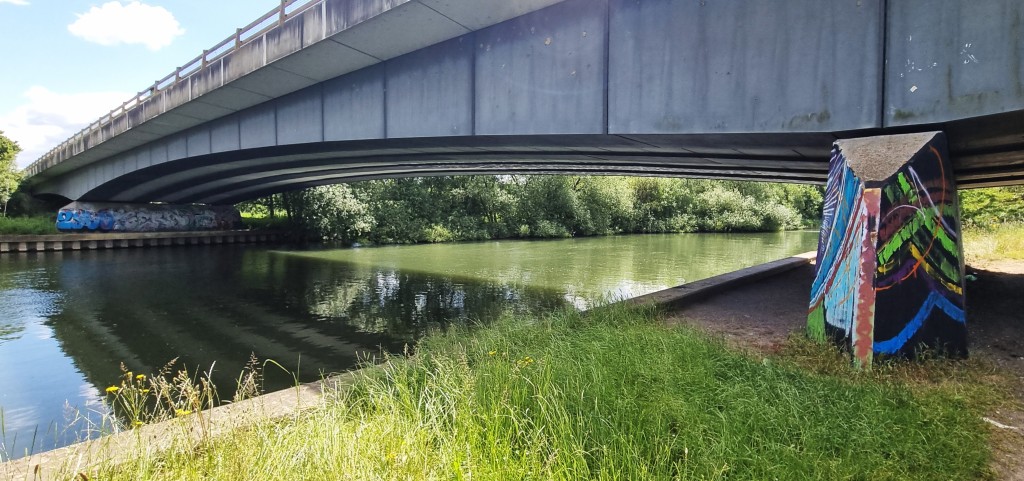
We passed under the low-slung bridge that carries the A4130 and, shortly afterwards, on the other bank, the Julius Gottlieb Gallery and Boathouse, designed by Basil Spence in 1968.
This was formerly part of Carmel College, a Jewish boarding school that closed in 1997. In the 1990s it was briefly the most expensive boarding school in Britain. In 2015 a former teacher was sentenced to 19 years for child abuse.
Tracy stopped beside a tree carrying a small plaque in memory of Dean Luckett (1987-2021), a fisherman who sadly drowned here. It is hard to imagine that such a beautiful spot witnessed such a tragic accident.

She released some petals into the water in memory of her own bereavement.
We arrived beside the Oxford Brookes boathouse just as the oarsmen were taking to the water. Tracy was surprisingly unimpressed by the sight of so much youthful lycra-clad muscle.

Indeed, she was far more interested in the activities of the tree surgeons on the opposite bank, busy cutting down a large specimen overhanging the water. The oarsmen rowed past, trying desperately to focus on their coaches’ instructions rather than tree’s dismemberment.
Continuing into Cholsey Marsh – where reside a colony of the rare Desmoulin’s Whorl Snail – our attention was drawn by a red cuddly toy with a vacant expression, perched on top of a wooden post.
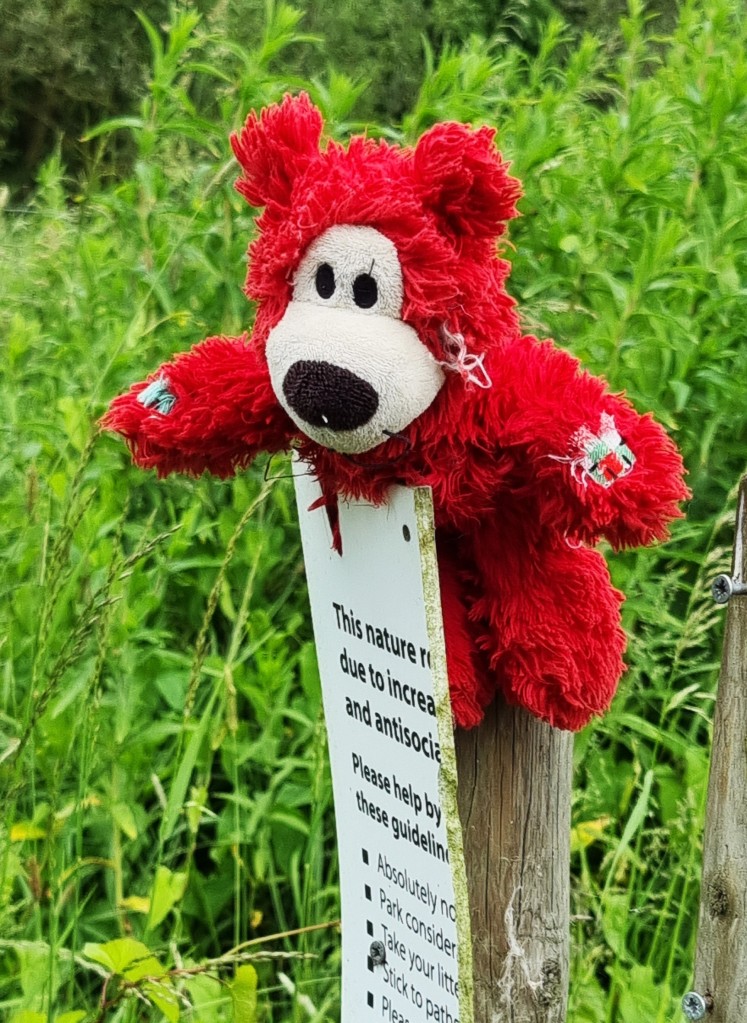
Cholsey, which is set back from the River, transferred from Berkshire to Oxfordshire in 1974. Agatha Christie had a home here and is buried in the churchyard. Poet John Masefield also resided here between 1915 and 1917, the landscape inspiring his collection ‘Lollingdon Downs and other poems, with sonnets’, published in 1917.
We passed a man in sandals navigating a muddy patch who acknowledged that he hadn’t come with the right footwear. There were still a few boggy sections even in early June.
A photographer said he hadn’t seen anything too remarkable to photograph that morning. We also stopped to chat to a man mowing the path, who explained how that helped to protect the conservation area.

Before long we were beneath the Moulsford Viaduct, which comprises twin bridges, side by side. The older, built between 1838 and 1840, was designed by Brunel, has a skew arch and is listed. It was constructed to carry the railway line from London to Bristol. The second, built in the 1890s, was needed when the line was widened.

A boardwalk passes under both bridges before the path leads up to the A329, north of Moulsford.
This protects the river frontage of Moulsford Prep School (boarding fees of £8,800 per term) and several expensive private houses – including Moulsford Grange and Grange Barn – whose value and exclusiveness would no doubt be compromised by the Thames Path passing by.
Indeed, we hoi polloi are not permitted to return to the riverside until Ferry Lane conveys us to the Beetle and Wedge Boathouse, a pub and restaurant that has a vested interest in walkers passing its doors.

I stopped to photograph the stretch we’d been denied before heading on towards Cleeve Lock. We also admired this ‘red kite’ on the opposite bank (just one of many we’d seen that morning).

South Stoke is over there, where novelist Edward Bulwer Lytton (1803-73) lived for a while, after his ill-fated marriage to fellow author Rosina Doyle Wheeler.
We were following a Le Boat hire vessel, forced to proceed at snail’s pace behind a four, who were being coached all the way down to the Lock.
This was first constructed in 1787, though rebuilt in 1874. It has the smallest fall on the Thames, at just two feet and three inches.
This stretch features prominently in Jerome K Jerome’s ‘Three Men in a Boat’ (1889).
In Chapter 18, our narrator remarks:
‘The river is not extraordinarily interesting between Streatley and Wallingford. From Cleve you get a stretch of six and a half miles without a lock. I believe this is the longest uninterrupted stretch anywhere above Teddington, and the Oxford Club make use of it for their trial eights.
But however satisfactory this absence of locks may be to rowing-men, it is to be regretted by the mere pleasure-seeker.
For myself, I am fond of locks. They pleasantly break the monotony of the pull. I like sitting in the boat and slowly rising out of the cool depths up into new reaches and fresh views; or sinking down, as it were, out of the world, and then waiting, while the gloomy gates creak, and the narrow strip of day-light between them widens till the fair smiling river lies full before you, and you push your little boat out from its brief prison on to the welcoming waters once again.’

Pete Townshend wrote much of Quadrophenia while living in a house behind the weir, but has subsequently moved on to Goring.
The lock-keeper eyed us suspiciously while we made our way to the bench on our side of the River, but gave us a cheery wave when he saw that we only wanted to picnic. We watched three or four boats pass through while eating our sandwiches, including the Le Boat hire mentioned above.
A dog was lying asleep on top of ‘Bronte’, a canal tug converted into a smithy, complete with forge, by blacksmith Brian Greaves. He and his wife live aboard a narrow boat called ‘Emily’ which tows ‘Bronte’ along the River. Both departed upstream as we finished our lunch.
Resuming our walk, we made towards Streatley, arriving into Church Lane. A blue plaque on St Mary’s proclaims that Lewis Carroll once preached there, in 1864.
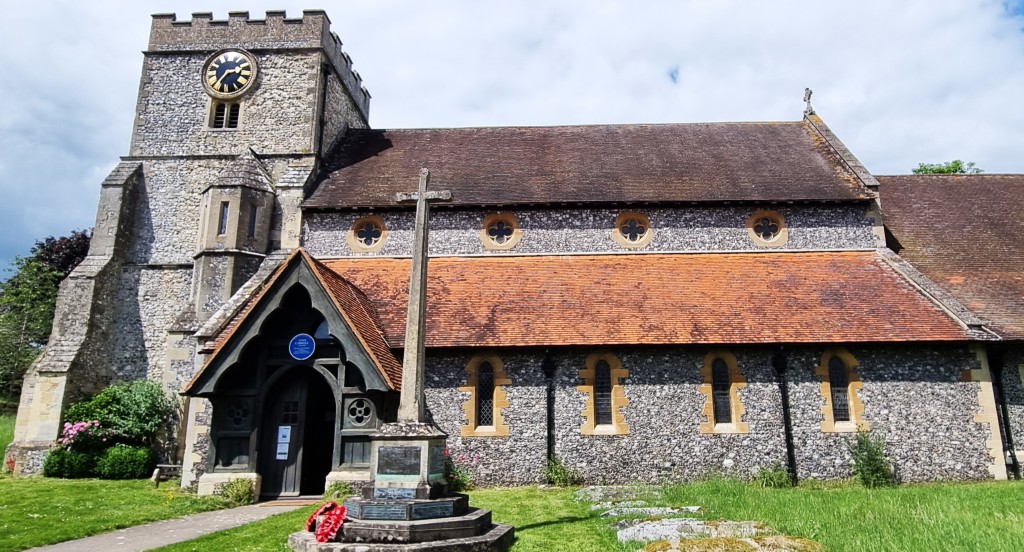
Although not much happens in Streatley, 60 people died here when the ferry capsized in 1674 and, in 1979, a suspected IRA bomb exploded in a postman’s letter bag…
…And the Swan was once owned by Danny La Rue.
These days, Streatley is connected by bridge with Goring on the opposite bank. Streatley is in Berkshire and Goring in Oxfordshire. The bridge crosses two arms of the Thames, flowing either side of an island. Though first constructed in 1837, this iteration dates from 1923.
There is a good view of Goring Lock, below.

Goring is larger than its neighbour, thanks to the railway line. Arthur ‘Bomber’ Harris lived here after the War and, in addition to Townshend, George Michael lived and died here.
Having crossed into Goring, we went directly to Pierrepont’s Café for the requisite coffee and cake. I ordered a slice of the inviting-looking coffee and walnut cake, about a third of which remained available – only to be informed, some minutes after paying, that the entirety had been sold already to someone else.
As you can imagine, I was distinctly unimpressed!
We now continued on through the so-called Goring Gap, a narrow cut between the Chilterns on one side and the Berkshire Downs on the other. The ground rises high above the River, reaching about 160 metres above sea level.

We admired a hefty fungus growing on a riverside tree, and a castellated mansion that might have been Townshend’s.
Just before the railway bridge, also one of Brunel’s, we found a fisherman replacing his shoes and socks – he said he’d been unable to resist a dip. A picturesque pill-box stood alongside the bridge.

Soon we were abreast of a large white ruin on the opposite bank. This is the Grotto, originally built by Viscount Fane in 1720, and subsequently expanded by the Sykes family who lived at nearby Basildon Park. It was set to become a luxury hotel but was badly damaged by fire in March 2021.
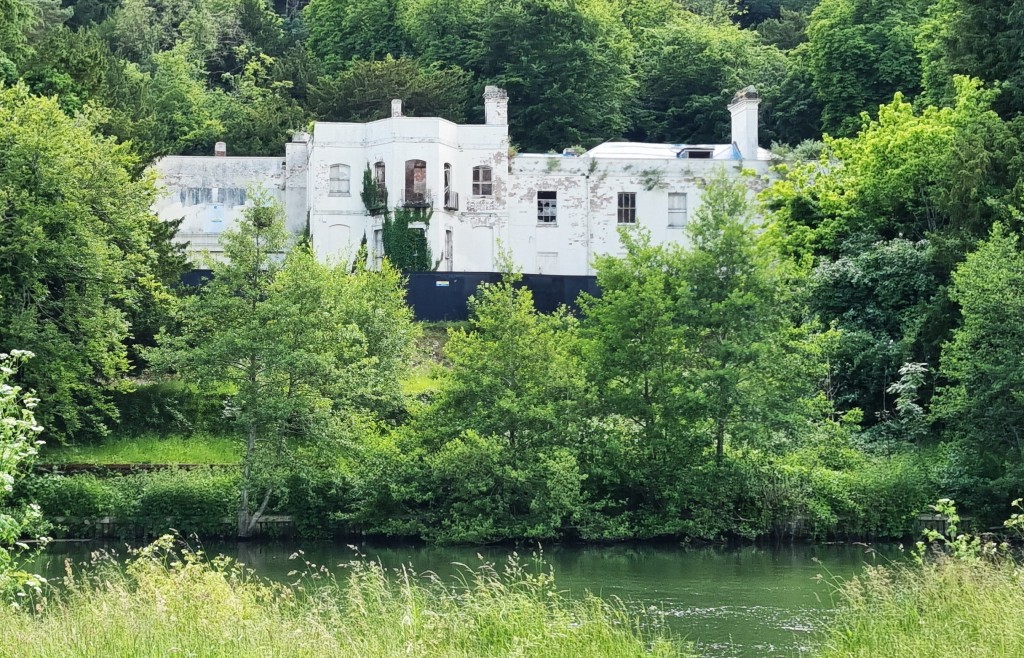
We said hello to two donkeys in a field.

Arriving beside Ferry Cottage at Gatehampton, now a private residence, we turned into the woods, beginning a gradual ascent, but stopping occasionally to look through the trees at the Thames below.
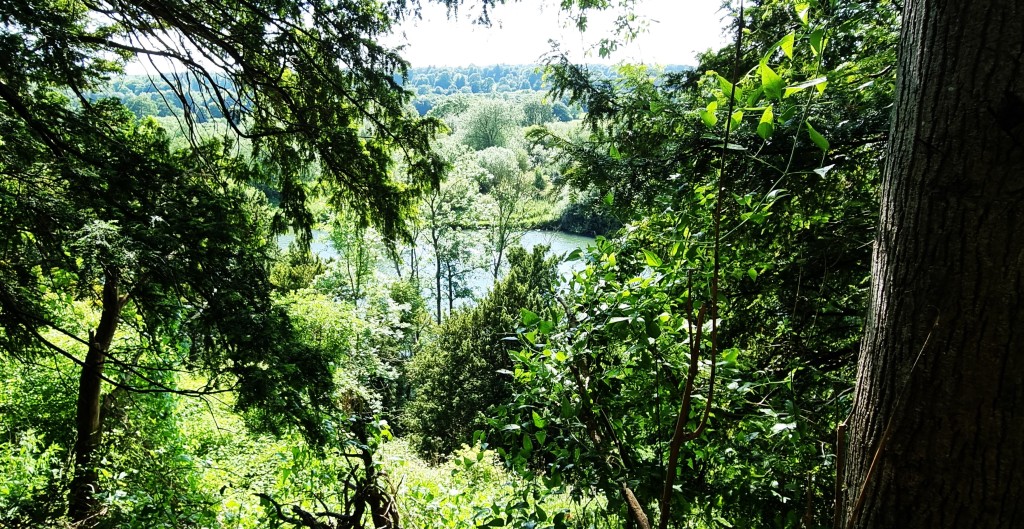
It was with considerable surprise that we spotted a male rambler, naked apart from his boots, hat and rucksack, walking along the other bank in the opposite direction. He was a fortnight early for Naked Hiking Day.
I told Tracy about the Naked Rambler.

The path now left the riverside to avoid the 125 acre estate of Combe Park. The eighteenth century manor house lay empty for several years until it was sold for some £10m in 2018.
The new owner decided to erect an 8-foot fence, resulting in several local objections. Now there’s a 7-foot fence running along much of Hartsock Bridleway, which isn’t too much better. The owner gets to look at the Thames while we get to look at his delightful fence.
Eventually, we arrived in Whitchurch-on-Thames, a well-heeled Oxfordshire village that faces Pangbourne on the Berkshire side. This elephant graces one of the gardens along the High Street.

The path runs through the churchyard of St Mary the Virgin, which retains Norman features but was almost entirely rebuilt in the 1850s.

Whitchurch Bridge was first constructed in 1792, but the latest version dates from 2014. Unusually, it has a thriving tollgate, charging motorists 60p for the pleasure of crossing. Pedestrians now go free, but that hasn’t always been the case.

It is Pangbourne that has the station, so is correspondingly larger.
The River Pang, a chalk stream and Thames tributary, runs for some 14 miles. There is also a River Bourne, a tributary of the Pang.
Kenneth Grahame, author of ‘Wind in the Willows’, lived in Pangbourne for the last few years of his life. Some say the location of his novel owes something to the Pang. There is also a public school that numbers Ken Russell amongst its alumnae.

We decided against a leisurely perusal of Pangbourne, walking briskly to the Station instead.
At Reading we boarded alongside a trainful of hot and tired commuters returning to Basingstoke, and from there we caught the train home.
TD
June 2024